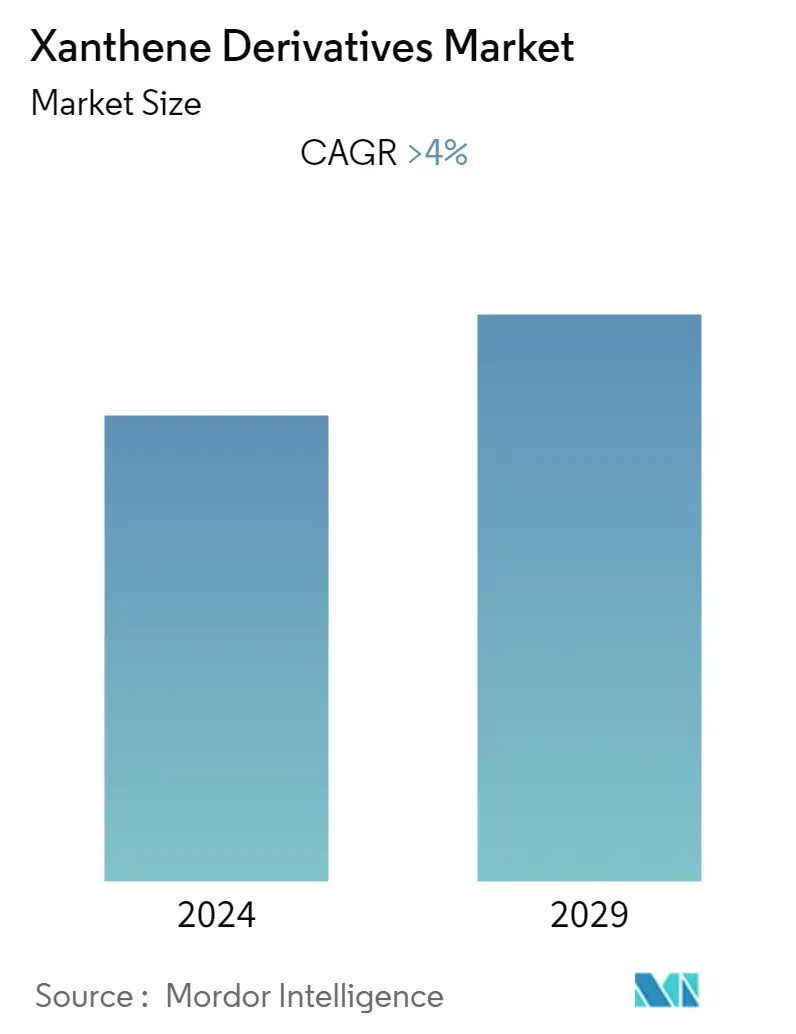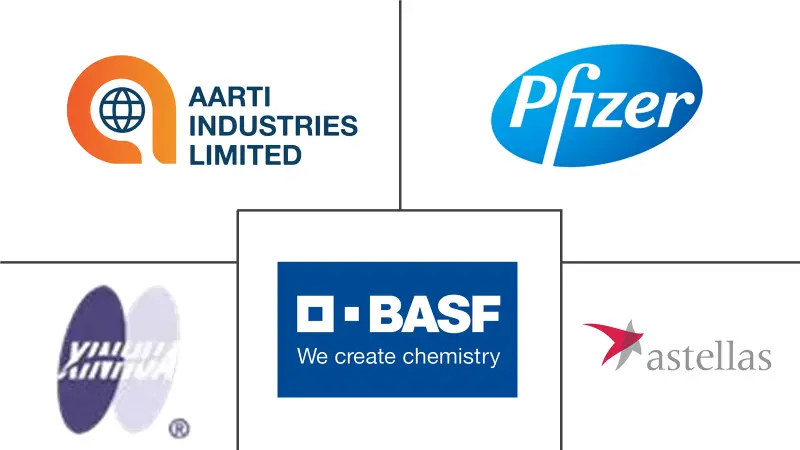Market Size of Xanthene Derivatives Industry

| Study Period | 2019 - 2029 |
| Base Year For Estimation | 2023 |
| CAGR | 4.00 % |
| Fastest Growing Market | Asia-Pacific |
| Largest Market | Asia-Pacific |
| Market Concentration | Low |
Major Players
*Disclaimer: Major Players sorted in no particular order |
Xanthene Derivatives Market Analysis
The xanthene derivatives market is projected to register a CAGR of over 4% during the forecast period (2022-2027).
Xanthene derivatives are primarily used in the pharmaceutical and food sectors and were largely unaffected by the COVID-19 pandemic. The demand for drugs increased during the pandemic, which in turn increased the sales of xanthene derivatives for drug preparation.
- In the short term, the growing adoption of xanthene derivatives in the pharmaceutical industry for treating asthma, eye disease, and other diseases is boosting market demand.
- Increasing demand from the food and textile sectors is another blooming opportunity for the xanthene derivatives market.
- The toxicity of xanthene derivatives in the food and drug sectors continues to limit the market's growth.
- The Asia-Pacific region is expected to dominate the xanthene derivatives market and is also likely to witness the highest CAGR during the forecast period.
Xanthene Derivatives Industry Segmentation
Xanthene is a yellow solid organic compound that belongs to a group of alkaloids used for mild stimulant effects. The xanthene derivatives market is segmented by derivative types, applications, and geography. By derivative types, the market is segmented into caffeine, theofyline, etofyline, theobromine, and other derivatives. By application, the market is segmented into pharmaceuticals, food, and others. The report also covers the market size and forecasts for the xanthene derivatives market in 16 countries across the major region. For each segment, the market sizing and forecasts have been done based on revenue (in USD Million).
| Derivatives | |
| Caffeine | |
| Theofyline | |
| Etofyline | |
| Theobromine | |
| Other Derivatives |
| Application | |
| Pharmaceutical | |
| Food | |
| Other Applications |
| Geography | ||||||||
| ||||||||
| ||||||||
| ||||||||
| ||||||||
|
Xanthene Derivatives Market Size Summary
The xanthene derivatives market is experiencing a steady growth trajectory, driven primarily by its applications in the pharmaceutical and food sectors. The market has shown resilience during the COVID-19 pandemic, with increased demand for pharmaceuticals boosting the sales of xanthene derivatives used in drug preparation. The pharmaceutical industry, in particular, is witnessing a surge in the adoption of xanthene derivatives for treating conditions such as asthma and eye diseases, which is significantly enhancing market demand. Additionally, the food and textile sectors are emerging as promising avenues for growth. However, the market's expansion is somewhat constrained by the toxicity concerns associated with xanthene derivatives in these sectors. The Asia-Pacific region is poised to lead the market, with expectations of the highest growth rate, driven by robust demand from countries like China, India, and Japan.
The pharmaceutical sector's research and development activities present substantial growth opportunities for the xanthene derivatives market. Innovations such as the development of xanthene dyes into fluorescent probes are further propelling the market's expansion in the pharmaceutical industry. The derivatives' applications in eye drops and cancer cell diagnostics underscore their significance in medical treatments. The Asia-Pacific region, particularly China, is a major consumer of xanthene derivatives, with the food and cosmetics industries also contributing to market growth. The region's dominance is supported by its substantial market share in these sectors, alongside the increasing pharmaceutical sales. The fragmented nature of the global xanthene derivatives market features key players like Pfizer Inc., BASF SE, and Astellas Pharma, among others, who are instrumental in shaping the market dynamics.
Xanthene Derivatives Market Size - Table of Contents
-
1. MARKET DYNAMICS
-
1.1 Drivers
-
1.1.1 Increasing Demand from the food and textile Industries
-
1.1.2 Expansion of Pharmaceutical Industries
-
-
1.2 Restraints
-
1.2.1 limited use of Xanthene derivatives
-
1.2.2 Other Restraints
-
-
1.3 Industry Value-Chain Analysis
-
1.4 Porter's Five Forces Analysis
-
1.4.1 Bargaining Power of Suppliers
-
1.4.2 Bargaining Power of Consumers
-
1.4.3 Threat of New Entrants
-
1.4.4 Threat of Substitute Products and Services
-
1.4.5 Degree of Competition
-
-
-
2. MARKET SEGMENTATION
-
2.1 Derivatives
-
2.1.1 Caffeine
-
2.1.2 Theofyline
-
2.1.3 Etofyline
-
2.1.4 Theobromine
-
2.1.5 Other Derivatives
-
-
2.2 Application
-
2.2.1 Pharmaceutical
-
2.2.2 Food
-
2.2.3 Other Applications
-
-
2.3 Geography
-
2.3.1 Asia-Pacific
-
2.3.1.1 China
-
2.3.1.2 India
-
2.3.1.3 Japan
-
2.3.1.4 South Korea
-
2.3.1.5 Rest of Asia-Pacific
-
-
2.3.2 North America
-
2.3.2.1 United States
-
2.3.2.2 Canada
-
2.3.2.3 Mexico
-
-
2.3.3 Europe
-
2.3.3.1 Germany
-
2.3.3.2 United Kingdom
-
2.3.3.3 Italy
-
2.3.3.4 France
-
2.3.3.5 Spain
-
2.3.3.6 Rest of Europe
-
-
2.3.4 South America
-
2.3.4.1 Brazil
-
2.3.4.2 Argentina
-
2.3.4.3 Rest of South America
-
-
2.3.5 Middle-East and Africa
-
2.3.5.1 Saudi Arabia
-
2.3.5.2 South Africa
-
2.3.5.3 Rest of Middle-East and Africa
-
-
-
Xanthene Derivatives Market Size FAQs
What is the current Xanthene Derivatives Market size?
The Xanthene Derivatives Market is projected to register a CAGR of greater than 4% during the forecast period (2024-2029)
Who are the key players in Xanthene Derivatives Market?
Pfizer Inc., BASF SE , Astellas Pharma, Shandong Xinhua Pharmaceutical Co Ltd. and Aarti Industries Ltd. are the major companies operating in the Xanthene Derivatives Market.

